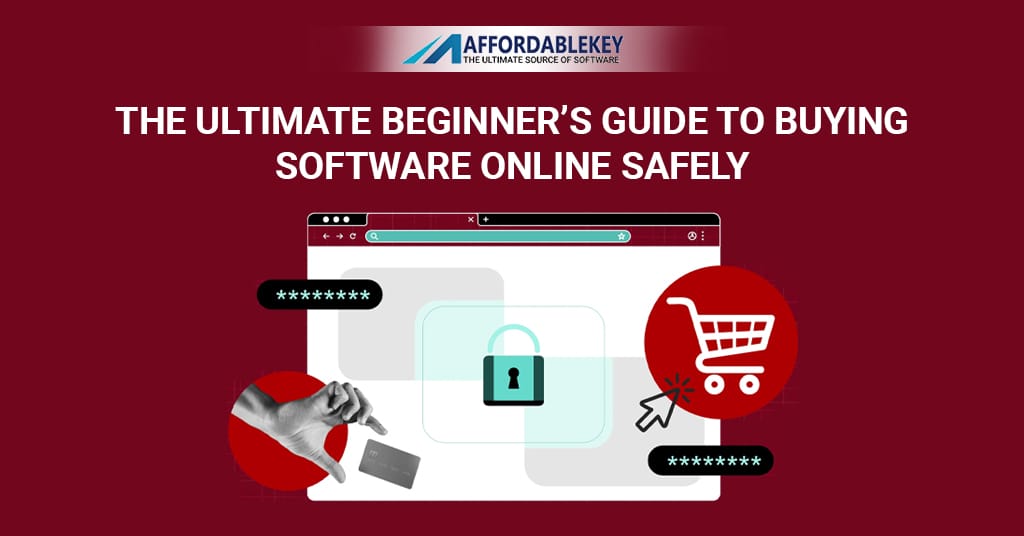The Ultimate Beginner’s Guide to Buying Software Online Safely

In today’s fast world, we depend on software. We use it for work, play, and school. Buying software online is easy. But it can also be risky. This Beginner’s Guide to Buying Software will help you. We will show you how to shop smart. We will show you how to stay safe. Many people do not know what to look for. They click and buy from bad sites. Then they lose money. Or they get fake software. That can hurt your computer. This guide will help beginners avoid that. If you are new to buying software, you are in the right place. We will make things easy to understand. We use short words. We use short sentences. We use simple steps. You will learn how to check if a store is safe. You will know what kind of software to buy. You will also know how to pay in a safe way. This Beginner’s Guide to Buying Software is made just for you. By the end, you will shop with confidence. Let’s start now and keep you safe online.
Why Buying Software Online Is Popular Today
People love shopping online. It is fast. It is simple. You do not have to go outside. You can shop from home. This includes buying software too. The Beginner’s Guide to Buying Software shows why this is the best way. You get to see many choices. You can compare prices. You can check what others say. That helps you buy smart. Most online shops are open all the time. You can buy software any day, any hour. Many websites offer good prices. They offer discounts. That saves you money. You can also find bundles. That means you get more for less. This is great for beginners. You will find tools for work. You will find games. You will find school apps. Everything is just one click away. Many stores now sell only online. They do not use CDs. You get a code. You download it. That is quick and easy. Still, be careful. There are fake sites too. The Beginner’s Guide to Buying Software will help you avoid those. If you are starting out, learn these steps. They keep you safe. Always check the website. Always read reviews. Always use safe payment. You get software fast and safe if you follow this guide. So buying online is not only smart. It is safe if done right.
Dangers of Buying Software from Untrusted Sites
There are many risks online. The Beginner’s Guide to Buying Software warns you early. Some sites are scams. They look real. But they are not. You may lose money. Or worse, you may download a virus. Fake software can harm your computer. It can steal your data. It can break your system. These sites offer big deals. Too good to be true? It probably is. Some even use fake reviews. That makes you trust them. But don’t. Learn the signs. A good site has clear contact info. It has safe payment. It shows licenses. Bad sites don’t. They hide info. They rush you. They ask for weird payments. The Beginner’s Guide to Buying Software shows how to spot this. Avoid websites with bad grammar. Avoid sites with no refund policy. Stay away from sketchy ads. Do not trust spam emails. Do not click random links. Use trusted browsers. Keep your antivirus on. It helps. Also, check for HTTPS. It means the site is secure. No lock sign? Do not buy. Use this Beginner’s Guide to Buying Software as your map. It keeps you on the safe path. If unsure, ask. Do not rush. Think before you buy. Safety first. Always.
How to Spot Fake Software Deals
The web is full of deals. But not all are real. This Beginner’s Guide to Buying Software shows red flags. First, check the price. Is it too low? Be careful. Software is not free. If a $200 app costs $10, it is fake. Also, check the website. Look at the design. Is it clean? Or full of ads? A bad site looks messy. Good sites look clean and safe. Also, look for the padlock. That means the site is secure. Read product details. Does it say “lifetime license” for every product? That’s not likely. Check reviews. But check real ones. Fake sites post fake reviews. Use trusted review sites like Trustpilot. Check the company name. Can you find it on other websites? If not, don’t trust it. The Beginner’s Guide to Buying Software helps spot these tricks. Also, ask questions. Send them an email. Do they reply fast? Do they answer well? If not, avoid them. Never trust pop-ups that say “limited time” only. That’s pressure sales. Good software stores do not do that. Take your time. Read well. Ask more. Then buy. This guide is your safe buddy. Use it every time you shop.
Importance of Software Licensing and What It Means
A license is proof. It says you own the software legally. It gives you the right to use it. This Beginner’s Guide to Buying Software explains why that matters. Without a license, the software may stop working. Or you could get sued. Or your computer could get locked. When buying online, always check the license. Is it full? Is it trial? Is it fake? You must know. Some sellers lie. They sell one license to many users. That is illegal. It is called piracy. Don’t buy from them. Always read the license terms. Know what you can do with the software. Can you move it to a new PC? Can you install it more than once? A good seller tells you that. They show clear terms. The Beginner’s Guide to Buying Software teaches you to read the fine print. Check how long the license lasts. One year? Lifetime? Also, make sure it comes from the maker. Microsoft, Adobe, and others give real licenses. Cheap keys may be used or stolen. Be safe. Ask for proof. Save your receipt. Save your email. You may need them later. A license is your key. Protect it. Use this guide to help you understand it well.
Choosing the Right Type of Software for Your Needs
Not all software is the same. You must pick what fits your needs. This Beginner’s Guide to Buying Software helps you do that. First, ask yourself: What do I need? Is it for work? Is it for fun? Do I need editing tools? Maybe just email and Word? Make a list. That helps. Then search for software that fits your list. Read about it. See what it does. Also, check your computer. Is it fast? Is it old? Make sure the software works on it. Look at system needs. That is very important. Also, check if it works with Windows or Mac. Some only work on one. Some work on both. Use this guide to find that info. If you are still not sure, ask. Most stores offer help. They suggest what to buy. Do not buy more than you need. That wastes money. Start small. Then add more later. Many tools offer free trials. Try them first. Then decide. The Beginner’s Guide to Buying Software says test before you buy. That way, you know what fits. Software is a tool. Use it smart. Choose what helps you. Not what looks cool. This guide keeps you focused. Buy what works best for you.
Recommended Payment Methods for Safe Transactions
Paying online should be safe. This Beginner’s Guide to Buying Software shows the best ways. Always use a secure payment method. Do not send cash. Do not use wire transfers. Use credit cards or PayPal. They offer protection. If something goes wrong, you can get your money back. Also, look for a payment padlock. It shows the site is safe. Some sites offer crypto. Be careful with that. It is hard to get refunds with crypto. Use what you know. Use what is safe. Do not share too much info. Only give what they ask. If a site asks for your ID or photo, think twice. That is odd. Also, save your receipt. Save the order email. It proves your purchase. Some good sites use third-party payments. That adds a layer of safety. This Beginner’s Guide to Buying Software tells you to trust known names. Stripe, PayPal, Apple Pay are all safe. Avoid bank transfers unless you trust the seller 100%. Think before you pay. Check the website one more time. Is the name spelled right? Fake sites often change a letter. Read the full URL. Be smart with money. This guide keeps your wallet safe.
Understanding Refunds and Return Policies
Sometimes things go wrong. You buy software. It does not work. Or it is not what you need. That is why refunds matter. The Beginner’s Guide to Buying Software says check return rules first. Every store is different. Some offer 30 days. Some only 7. Some offer no refund. Read the policy page. Is it clear? Or hard to find? A good site shows refund rules upfront. They use simple words. They tell you how to ask for a return. They tell you what to do. Keep your receipt. You will need it. Take a screenshot if needed. Some sellers ask for that. Also, ask how you get the refund. Back to your card? Store credit? Know that before you buy. Do not wait. Ask early. The Beginner’s Guide to Buying Software tells you to stay alert. If a site says “no refunds at all,” be careful. That is a red flag. Trusted stores offer help. They care about your needs. Bad ones ignore you. They take your money. Then vanish. Know the difference. Use this guide. Buy from sites that treat buyers well. You deserve fair treatment. You deserve a refund if things go wrong. Know your rights. Always.
Signs of a Legit Online Software Store
How do you know if a site is real? The Beginner’s Guide to Buying Software gives clear tips. Look at the site name. Is it well-known? Google it. Check for the padlock. That means it’s safe. Look at the contact page. Does it show an address? A phone? An email? If not, be careful. Read their “About” page. Do they say who they are? Do they show photos? Check for social pages. Are they active on Facebook or Twitter? Real stores are. Also, look for reviews. Do they have good feedback? Bad sites have none. Or only fake ones. Read what real users say. Use trusted review sites. The Beginner’s Guide to Buying Software wants you to dig deep. Check how long the site has been online. New sites may not be safe. Older ones are better. Also, search for scam reports. If people warn you, listen. Avoid sites with odd names. Or weird logos. Good stores use clear brands. They are easy to trust. One trusted site is AffordableKey. They offer licensed software at fair prices. Real key. Real support. Real value. Use this guide. Spot the fakes. Trust the real.
Tips to Compare Prices Without Falling for Scams
You want the best price. But you also want safety. This Beginner’s Guide to Buying Software helps balance both. Start with trusted sites. Make a list. Then compare prices. But do not just look at the number. Check what comes with it. Does it include updates? Is it a full license? Look for hidden fees. Some sites add charges at checkout. Read the fine print. Also, check the version. Is it the latest? Or an old one? Cheap may mean outdated. That matters. Use comparison tools if needed. They help see price changes over time. Some browser extensions do this. Be smart. Set a price range. If a deal is way below that, stop. It might be fake. Good deals are often within 20% of market price. More than that is risky. The Beginner’s Guide to Buying Software wants you to save money safely. Check if the site runs sales often. Wait for those. Look at bundles too. They offer more value. But always check the source. Never trust pop-up deals. Never rush. A few minutes of checking can save you from a big mistake. Compare. Confirm. Then buy.
Reading Reviews Before Buying Software
Reviews are gold. They show what others think. This Beginner’s Guide to Buying Software says always read them. Start with real review sites. Like Trustpilot. Or sitejabber. Do not just read stars. Read words. What do users say? Did they get the software fast? Did it work? Was support helpful? That tells you a lot. Also, check for patterns. If many people say the same thing, it’s likely true. Good or bad. Look at dates too. Are they recent? Are they real? Some sites pay for reviews. Watch out for that. Too many 5-stars with no detail is a red flag. Real reviews have pros and cons. Check YouTube too. Many users post what they bought. You can see how it works. The Beginner’s Guide to Buying Software reminds you: reviews help you decide. But trust your gut too. If something feels off, skip it. Reviews guide you. But do not replace your own checks. Use both. Safe shopping needs both info and care.
Promoting Safe and Budget Software with AffordableKey
Many beginners ask where to start. One smart place is AffordableKey. They offer real software. With real licenses. At fair prices. The Beginner’s Guide to Buying Software recommends them. Why? They are clear. They show what you get. No tricks. No hidden terms. You get instant keys. You get full support. They help if you have a problem. Their website is clean. Their contact info is real. They even have guides. That helps new buyers. You can get Windows, Office, and more. All at low cost. But still legal. Still safe. That is rare. Many stores cut corners. AffordableKey does not. That’s why we list them here. You can compare prices. You can read user feedback. Everything is open. That builds trust. If you want a good first buy, start there. They also offer volume deals. For students. For small teams. That helps save more. They follow refund rules. They answer emails fast. They are made for people like you. Use this Beginner’s Guide to Buying Software to explore their store. It is one of the few safe picks. Start smart. Start safe.
Common Mistakes Beginners Make When Buying Software
Everyone makes mistakes. But this Beginner’s Guide to Buying Software helps you avoid them. One big mistake is rushing. Don’t click the first deal you see. Stop and check. Another mistake is not reading details. You must know what you’re buying. Is it a full version? Or trial? Is it Windows or Mac? That matters. Some people skip reviews. That’s risky. Reviews show real user views. Don’t ignore them. Also, some forget to check if their PC can run the software. That causes trouble. Always check system needs. One more mistake is not saving receipts. You may need it later. Save emails. Save product keys. Take screenshots. Some people fall for ads. Flashy banners can be fake. Real stores don’t use tricks. They use facts. This Beginner’s Guide to Buying Software shows you what to avoid. Don’t pay with risky methods. Use safe options only. Don’t trust sites with no support. If they can’t help before you buy, they won’t help after. Ask questions. Read terms. Think before you click. Buying software can be easy. But only if you take care. Learn from others. Avoid these mistakes. Stay smart.
Conclusion: Final Thoughts on Buying Software Online
Now you know the basics. This Beginner’s Guide to Buying Software gave you the full picture. From safe sites to smart choices. From fake deals to real refunds. You learned what to watch for. You learned how to choose what fits you. Buying online is fast and easy. But it can be risky if you don’t take care. That is why this guide matters. Use it every time you shop. Make it your go-to plan. Always check the site. Always read the fine print. Always look at reviews. Use safe ways to pay. Look for stores like AffordableKey. They make things simple. They make things legal. That is peace of mind. Your money and your data are worth protecting. Use this Beginner’s Guide to Buying Software as your safety net. Share it with friends too. Many people fall into traps. You don’t have to. You now have the tools. The right tools. Smart buyers ask questions. Smart buyers read and plan. Be one of them. Start today. Buy smart. Stay safe. Get the software you need. Without the worry.
Thanks for reading.










